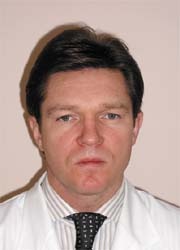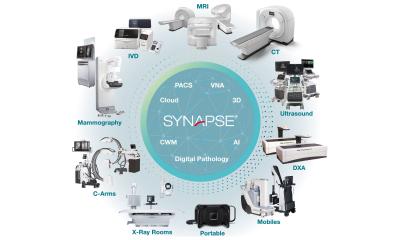Want to invest into healthcare?
Then you must invest in radiology
Dr A Tamosiunas, Associate Professor at the Radiology Centre in the Medical Faculty at Vilnius University, Lithuania, and Director of the Radiology Centre at Vilnius University Hospital, discusses the present situation and future development of the radiology services in Lithuania with EH correspondent Andrius Vagoras

To invest in healthcare you must invest in radiology – that’s as clear to Dr A Tamosiunas as is the huge amount of funding this requires. Over the next four years, he points out, about 62 million euros should be spent on radiology equipment alone. That’s the Government’s official estimation – endorsed, several months ago, by the Health Ministry within the investment programme Optimisation of Radiology Services in Lithuania 2006–2010.
However, the funding does not correspond with the real demand for radiology (at least five times higher). According to Dr Tamosiunas, who contributed to the programme: ‘This is a very minimal amount, which is absolutely necessary to avoid expanding the existing gap between state-of-the-art radiology in Lithuania and other European countries. Besides, it must be assumed that the investment programme covers only equipment, and that is just one issue. The same applies to issues of radiological examination costing by the State Patient Fund. Presently they do not meet the real cost.’
The programme’s analysis of the current state of radiology in Lithuania clearly shows that it is very complicated.
Most existing conventional X-ray machines do not have optical amplifiers and only 13 of the 378 machines are partially digitised. The majority are over 20 years old and should be changed as soon as possible. Per se, an X-ray procedure is considered to be a consultation with a radiologist, and is not reimbursed separately by the SPF. Formally, it is equivalent to a consultation with other specialists – who need no equipment.
Additionally, 23 of the country’s 35 computer tomography (CT) scanners are single slice – and only four are 16-slice. ‘There is an urgent need to acquire at least two 64-slice CT scanners. This would allow cardiac and peripheral blood vessels examinations to be switched from the costly invasive angiography procedure to a non-invasive procedure. We also need multi-slice (at least 16 slice) CT scanners in hospitals that provide emergency services, and very close to the hospital emergency units. This is absolutely necessary for urgent and definite diagnoses in emergencies and for patient allocation to the right department,’ Dr Tamosiunas explained. The existing cost of a CT examination (about 50 euros) is definitely inadequate, even to cover the costs of a very simple (one or two slices) CT investigation and this valuation is not differentiated. It means, that the more often a sophisticated CT scanner is used, the more financial loss is ‘gained’ by the institution. Unfortunately, even this inadequate valuation is not endless. The SPF can only reimburse a definitive number of CT investigations. Usually we reach this ‘limit’ by the middle of a calendar year, and all other CT investigations performed after that limit diminish the existing valuation. At the end of 2006, for example, it turned out that the official valuation of CT examination was lowered by 40%, due to the performance of over-the-limit CT examinations.
The overall accessibility of magnetic resonance imaging (MRI) scanners in Lithuania is very unsatisfactory. MR angiography and multi-phase MRI widely performed in most European Union countries are almost never performed in Lithuania. Four in eight MRI units are in private hospitals and have low accessibility due to the very high cost per examination. MRI costing issues are identical to CT costing. It is also not differentiated, very inadequate and limited to the calendar year.
Obviously, the biggest technology gap in Lithuanian radiology is in nuclear medicine. Four in five gamma cameras are over 20 years old and only one rotational SPECT gamma camera (in Kaunas Medical University Hospital) fits current European standards; Vilnius, the capital city, needs at least five.
According to the Dr Tamosiunas, if costing issues are not solved very soon, managing other problems will become very complicated. Current valuation is two or three times less than the actual cost. It leaves no opportunities to set funds aside, increase salaries, and organise training. ‘Setting adequate funding for radiology examinations in Lithuania could be viewed as an investment – which also would be very well timed because it would enable an overall improvement in healthcare and conserve future funds,’ Dr Tamosiunas pointed out. Access to specialised healthcare is still good, he added, but the right choice of treatment is not always optimal due to misdiagnoses. The benefits from constant and well-differentiated investment in radiology are well known: earlier diagnoses, earlier treatments and much else for patients and services.
Things are not getting worse – ‘That’s the greatest news,’ said Dr Tamosiunas, smiling. Attention and support from government organisations is constantly increasing and, though very gradual, the perception of radiology’s exclusiveness is evolving: only radiology can identify diseases when other medical specialities can find no typical or other symptoms.
The role of the radiologist is gaining prestige. For many years, top medical graduates rarely chose to work in this field; last year 60 graduates from the Vilnius Medical Faculty applied for the one place in radiology training. This four-year curriculum has been prepared according European standards, and should be recognised in other EU countries. Two Lithuanian medical faculties can train 8–9 radiologists annually, which Dr Tamosiunas considers insufficient. Almost 25% of Lithuania’s 400 (approx.) radiologists will retire in a few years. In addition, only about a hundred radiologists have the full range of skills needed in modern radiology. Many practicing radiologists need to attend courses, for which funding is not available. Thus the only real way to solve the dearth of radiologists would be to increase future traineeships by 10–15.
For now, Dr Tamosiunas’ main concern is the introduction of a SPECT scanner to the Radiology Centre. As this is a first for Vilnius University Hospital, there are additional needs: a qualified physician, sufficient SPF funding, new accommodation, etc. This year the doctor expects that the Ministry of Health’s working group in charge of radiological examination costing will make the right decisions about the indications for those examinations and their costs. Consequently, work with the SPECT and other equipment would not only provide physicians with examination results, but also maintain the new equipment and new jobs. Otherwise, it will become just an additional staff workload and, in due course, present new problems.
01.05.2007











